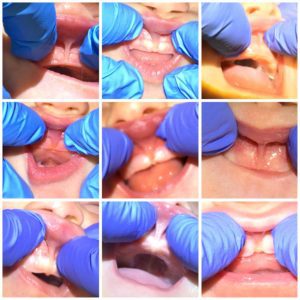Arizona Breastfeeding Medicine and Wellness approach to Tongue Tie:
A tongue tie is more than just a tongue tie…..
At Arizona Breastfeeding Medicine and Wellness, we have created a unique, family- centered approach to treating tongue, lip, and buccal ties, resulting in the proper diagnosis, treatment, and aftercare of patients with tongue, lip, and buccal ties. Dr. Cara works closely with IBCLCs and other providers in the community as well as body workers to insure that we are addressing the issue from the perspective of both mom and baby. Dr. Cara takes the time to meet with all tongue tie patients and performs all of the procedures. Â She has completed over 10000+ procedures to help improve tongue tie symptoms in infants, children, and adults.
On this page, we have tried to answer the questions related to tongue tie and the tongue tie procedure.
What is tongue tie?
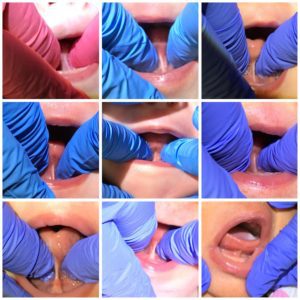
The medical definition of tongue tie is: An embryological remnant of tissue in the midline between the undersurface of the tongue and the floor of the mouth that restricts normal tongue movement.
What does that mean to you or I?
A small band of tissue underneath the tongue is preventing the tongue from moving left to right, extending out of the mouth, and lifting to the roof of the mouth.
Then, doesn’t everyone have a tongue tie?
No! A person is considered to have a tongue tie, only when the band of tissue under the tongue affects the normal function of the tongue. The tongue is important at all ages and stages of life from birth long into adulthood.
Types of tongue ties
Tongue ties are rated on their location under the tongue. Some tongue ties are considered anterior, or near the front of the tongue, while others are considered posterior or near the back of the tongue.
It is important to note that ALL levels of tongue tie are significant. Remember, we consider a person tongue tied when the tongue is not able to function properly due to the restriction.
As you can see in the photos below, each tongue is restricted due to a tongue tie.

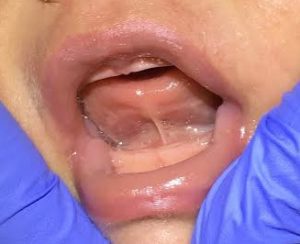
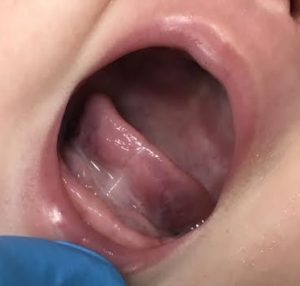
It is important to note ever person’s anatomy is different. Only a professional that specializes in tongue tie can give an accurate diagnosis of the type of tongue tie and to the degree that it affects normal tongue function.
How does tongue tie affect infants?
Tongue tie in infants can cause difficulty with feeding both on the breast and on the bottle. Because the tongue is not able to extend, lift, or lateralize well, infants have trouble manipulating both the breast and bottle. Noticeable symptoms include, but are not limited too:
- Poor latch, suck
- Poor weight gain, excessive weight loss
- Fussy baby, colic, frustrated
- GERD (reflux)
- Clicking on the breast
- Frequent latching and unlatching on the breast
- Sleepy, tired baby on the breast
- Excessive air intake, dribbling mouth from milk
- Gumming, chewing the breast
- Unable to hold pacifier, Shoots pacifier
- Poor bottle feeding, leaking
- Long feedings, lasting up to an hour, frequent feedings, insatiable baby
- Thrush
How does tongue tie affect breastfeeding?
In addition to the effects noted above, breastfeeding moms experience:
- Poor milk supply
- Oversupply
- Severe pain when breastfeeding
- Bleeding, cracked or blanched nipples
- Nipple vasospasms
- Nipple flattening post-breastfeeding
- Mastitis
- Clogged ducts
- Nipple thrush
- Breast lumps
- Frustration and anxiety associated with breastfeeding
- Problems bonding with the baby
Tongue tie, lip tie, buccal tie, high palate, recessed chin: What does it all mean?
Tongue ties typically are accompanied with a lip tie, high palate and recessed chin. While tongue tie, lip tie, high palate, and recessed chin are exclusive of on another, their combination of all of these can contribute to significant issues with breastfeeding.
High palates make it difficult for the tongue to properly elevate to the roof of the mouth to compress the nipple for breastfeeding (or bottle feeding) and thus can hinder the tongue’s ability in contributing to proper jaw development. A recessed chin makes it difficult to maintain and hold a latch, due to potential misalignment of the jaw. A lip tie (which is further discussed below) contributes to increased air intake, resulting in reflux and colic.
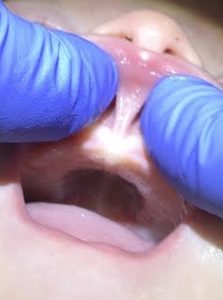
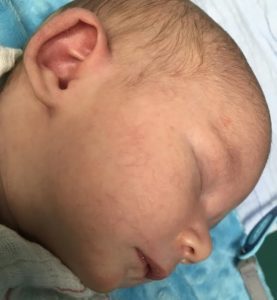
How do tongue/lip/buccal ties affect an older child?
Untreated or undiagnosed tongue tie can present different symptoms in toddlers and older children. Tongue tie can cause food aversions due to not being able to properly manipulate food in the mouth. Tongue ties can also cause speech issues, specifically pronouncing the ‘r’, ‘l’, ‘s’, ‘c’ and ‘k’ sounds. This is because the tongue cannot properly elevate to the roof of the mouth.
Some children with tongue tie also experience sleep apnea as the restriction of the tongue does not allow for the airway to be blocked off while sleeping, resulting in the tongue slipping down the throat and occluding the airway.
Untreated tongue tie can also lead to malocclusion of the teeth and improper jaw development. The proper placement and movement of the tongue is instrumental in proper jaw growth and development. When a tongue is restricted, proper pressure is not placed on the upper or lower jaw to allow for expansion, resulting in small jaws and necessity for orthodontic care that may involve removal of adult teeth and braces to properly align teeth.
How does tongue tie affect adults?
Emerging research suggests that adults with untreated tongue ties often experience: TMJ symptoms, tension headaches, neck and shoulder pain, and sleep apnea.
The reason for these symptoms is that the jaw has improperly formed over time resulting from the tongue not being able to elevate to the roof of the mouth to create a seal.  The result, specific to sleep apnea, is mouth breathing which can result in the tongue slipping down the back of the throat, occluding the airway while sleeping.
What is a lip tie?
A lip tie is medically defined as an attachment of the upper lip to the maxillary gingival tissue.
Just as a tongue-tie is a small piece of tissue under the tongue, the lip tie is a small piece of tissue between the upper lip and the gums. This piece of tissue prevents the lip from flanging out correctly during breast and bottle feedings.
There is some research that lip ties are also associated with improper jaw development and adult tooth placement.
What symptoms indicate the need for a lip tie correction?
Research presented at the Academy of Breastfeeding Medicine 2016 Conference suggests that unresolved lip ties are associated with reflux and increased gas in infants. The reason for this association is that the lip tie prevents a perfect seal from being formed around the breast or bottle resulting in air being drawn and swallowed during feedings.
What is a buccal tie?

A buccal tie is an atypical mucosal tether that extends from the cheek to gingiva. Buccal ties contrast from upper ties, which extend from the midline upper lip to the gingiva. Buccal ties are asymmetrical; some have ties on both right and left, some only on one side.
Buccal ties can have affects across a life span: Difficulty breastfeeding, can affect smile, can cause discomfort as the cheek lifts, possible food entrapment depending on severity.
At Arizona Breastfeeding Medicine and Wellness, we are working with bodyworkers and speech language pathologists (SLPs) to contribute to the research and release of buccal ties. Not much research has been completed in this area.
Do all lip and buccal ties require correction?
No! Just as with tongue ties, lip and buccal ties are not correct unless they present functional problems. It is unnecessary to put a child through an unnecessary procedure if there will be no benefit.
Should tongue, lip, and buccal ties be corrected at the same time?
Typically, yes. If multiple ties are noted, all ties should be corrected at the same time to allow for proper movement of the bones and muscles. Assessment is not sole based on anatomy, but also on function. Dr. Cara approaches each family with an open mind and takes into account the totality of the symptoms before making a final recommendation.
How are tongue ties treated?
Correction of a tongue tie means that the tissue is released to allow better mobility of the tongue. Tongue tie clippings can be performed with scissors, diode lasers, erbium lasers, CO2 lasers, and electrocautery.
At Arizona Breastfeeding Medicine and Wellness, we use a LightScapel CO2 laser to perform all our tongue and lip tie procedures. In our experience, we have found that the CO2 laser results in less scar tissue and reattachment of tissue post procedure.
Who will benefit from a tongue tie release?
Any person (infant, toddler, child, or adult) that have symptoms associated with tongue tie.
What if I choose not to correct my baby’s tongue tie?
Going through with a tongue tie procedure is a very personal choice. We try to present you with all of the information, but the decision is ultimately up to you and your family. We 100% support you in your decision making process and know that you will make the best choice for your baby and your family.
Will the tongue tie procedure hurt my baby?
The tongue tie procedure will cause discomfort. We sometimes use a topical anesthetic. Afterwards, there can be discomfort caused by inflammation of the tissue as well as inflammation in the muscles of the jaw, neck and shoulders.
We recommend using baby Tylenol and Arnica to treat the pain. Most babies require Tylenol and Arnica for 12- 48 hours post procedure, though we do see a range of discomfort. Some children need one dose of medication and others may need as many as 5. Every baby is different. It is important to follow your baby’s cues.
Aftercare
Aftercare is extremely important to prevent the tongue (or lip) tie from reattaching. The exercises we recommend are designed to keep the tongue moving and prevent it from healing back in the same way it was before the correction.
During your visit with our office, we will personally go over the exercises and have you make a video of the exercises being performed on your child.
Working with an IBCLC
Chances are if you are having breastfeeding difficulty you are already working with an International Board Certified Lactation Consultant (IBCLC). If you are not, we highly recommend seeking a consultation with one after the procedure to help improve the latch of your baby.
When you come to our clinic, know that you will individually work with an IBCLC during your entire appointment.
IBCLCs have fantastic knowledge and are very supportive in the coming days and weeks after your tongue tie revision.
Tongue tie and bodywork/chiropractic care
It can be extremely beneficial to seek the care of a chiropractor or cranio-sacral therapist who is familiar with infants and tongue tie.
When a tongue tie is released, musculature in the mouth, jaw, neck and shoulders can shift. Bodywork can help with alleviating tension and helping with structural alignment of the jaw, neck, and back.
Additional tongue tie resources
CO2 laser Frenotomy article by Dr. Cara
Tongue-Tied: How a Tiny String Under the Tongue Impacts Nursing, Speech, Feeding, and More

